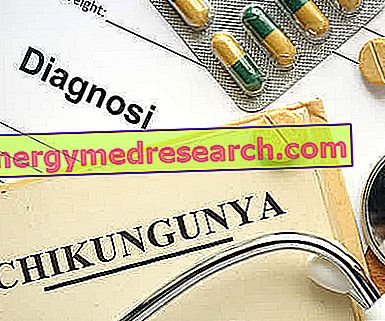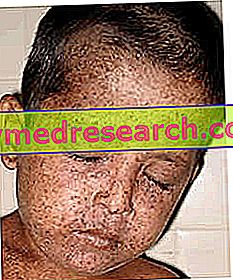Definition
Chikungunya is an infectious disease of viral origin, particularly widespread in Africa and Asia, although some cases have also been identified in Europe.
To be more precise, chikungunya is a zoonosis that is transmitted to humans by particular types of mosquitoes.
Causes
As mentioned, chikungunya is a viral infection that is transmitted to humans through the bite of infected mosquitoes, belonging to the genus Aedes . More specifically, the mosquitoes responsible for transmitting the infection are Aedes aegypti and Aedes albopictus (the latter is commonly referred to as a "tiger mosquito").
The virus that is transmitted is the so-called Chikungunya virus (CHIKV), an RNA virus belonging to the Togaviridae family.
Symptoms
The typical manifestations of chikungunya are the sudden appearance of very high fever, accompanied by joint pain and stiffness.
Other symptoms that can manifest are: headache, weakness, nausea, epistaxis, gingival bleeding, ecchymosis and rash.
Furthermore, chikungunya can cause serious complications, such as myocarditis, hepatitis, uveitis and retinitis, acute renal failure, meningoencephalitis and septic shock.
Information on Chikungunya - Chikungunya Fever Treatment Drugs is not intended to replace the direct relationship between health professional and patient. Always consult your doctor and / or specialist before taking Chikungunya - Chikungunya Fever Treatment Medications.
drugs
In some cases, chikungunya tends to resolve spontaneously within about ten days, even if the joint pain it causes may even persist for a few months.
Unfortunately, at the moment, there are no specific antiviral drugs to counter the Chikungunya virus, nor is there a vaccine (although there are some in the experimental phase).
Therefore, the treatment of chikungunya is purely symptomatic and involves resting, taking fluids and administering anti-inflammatory drugs (both non-steroidal and steroidal, depending on the case) and antipyretics for the control of fever and pain.
Since there are no vaccines for chikungunya, the most effective preventive method consists in protecting themselves from the bites of potentially infected mosquitoes, through the use of protective clothing, special repellent lotions, mosquito nets and insecticides to be used both against larvae, both against adult mosquitoes.
It should also be remembered that - to prevent further exposure to the vector and to discourage the spread of the viral infection - during the first days of the disease, patients who contract the chikungunya virus should stay in closed places and take the precautions described above, so as to avoid being bitten again by mosquitoes.

Paracetamol
Paracetamol (Tachipirina ®, Efferalgan ®, Panadol ®), otherwise known as acetaminophen, is a drug with strong antipyretic activity, which is why it is very useful in treating fever that is triggered by the chikungunya virus contraction.
It is available in various pharmaceutical forms suitable for the most diverse routes of administration (from oral to parenteral).
When administered orally, the dose of paracetamol used is 500-1, 000 mg, to be taken every 6-8 hours.
NSAIDs
Non-steroidal anti-inflammatory drugs can be used effectively to counteract fever and joint pain triggered by chikungunya, thanks to their analgesic, antipyretic and anti-inflammatory properties.
Generally, NSAIDs are administered orally, but in some cases, for the treatment of joint pain, they can also be used in topical pharmaceutical formulations.
Among the active ingredients mostly used in the symptomatic therapy of chikungunya, we find:
- Ibuprofen (Brufen ®, Moment ®, Nurofen ®, Arfen ®, Actigrip fever and pain ®, Vicks fever and pain ®): when ibuprofen is administered orally, the dose of drug to be taken must be established by the doctor for each patient, taking care not to exceed the maximum dose of 1, 200-1, 800 mg of drug per day.
- Naproxen (Momendol ®, Synflex ®, Xenar ®): when administered orally, the usual amount of naproxen is 500-1, 000 mg of drug per day, to be taken in divided doses every 12 hours.
If, on the other hand, preparations are used for cutaneous use based on naproxen, it is advisable to apply the product in the affected area twice a day.
Corticosteroids
In patients suffering from severe joint pain and in whom treatment with NSAIDs has been shown to be ineffective, the doctor may decide to administer corticosteroid drugs.
In these cases, steroid anti-inflammatory drugs are usually administered orally.
However, in situations where joint pains are particularly severe and refractory to any other treatment, the doctor may decide to resort to intra-articular corticosteroid injections. However, this practice is extremely delicate and must be performed only and exclusively by personnel specialized in this kind of therapy.
Among the various active ingredients that can be used in the treatment of joint pains triggered by chikungunya, we find:
- Methylprednisolone (Urbason ®, Medrol ®, Solu-Medrol ®): if used orally, the dose of methylprednisolone administered can range from 4 mg to 48 mg of active ingredient per day. The exact amount of methylprednisolone to be administered must be established by the doctor on a case by case basis.
Furthermore, methylprednisolone is also available for intra-articular administration in pharmaceutical formulations both alone and in association with local anesthetic lidocaine (see the medicinal product Depo-Medrol + Lidocaine ®).
- Prednisolone (Sintredius ®): the dose of prednisolone usually used by mouth is 10-30 mg a day. The most suitable drug dosage for each patient should be established by the doctor.
- Prednisone (Deltacortene ®): prednisone is available for oral administration as tablets. The dose of active ingredient usually administered is 10-15 mg a day. However, even in this case, the exact dosage of the drug will be established by the doctor on an individual basis for each patient.



